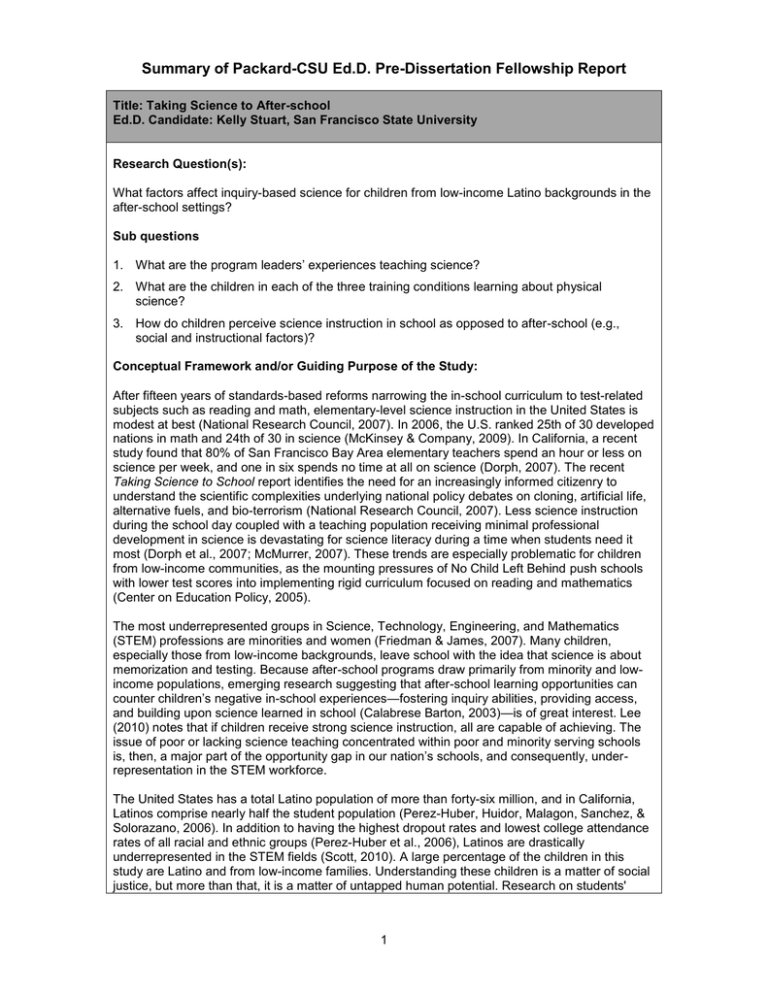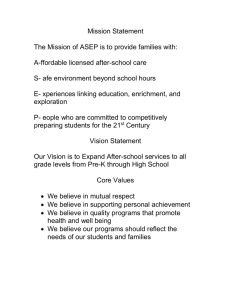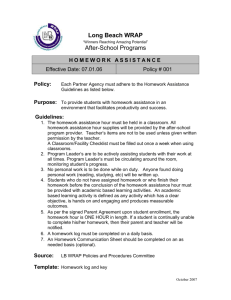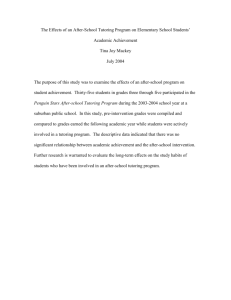Summary of Packard-CSU Ed.D. Pre-Dissertation Fellowship Report
advertisement

Summary of Packard-CSU Ed.D. Pre-Dissertation Fellowship Report Title: Taking Science to After-school Ed.D. Candidate: Kelly Stuart, San Francisco State University Research Question(s): What factors affect inquiry-based science for children from low-income Latino backgrounds in the after-school settings? Sub questions 1. What are the program leaders’ experiences teaching science? 2. What are the children in each of the three training conditions learning about physical science? 3. How do children perceive science instruction in school as opposed to after-school (e.g., social and instructional factors)? Conceptual Framework and/or Guiding Purpose of the Study: After fifteen years of standards-based reforms narrowing the in-school curriculum to test-related subjects such as reading and math, elementary-level science instruction in the United States is modest at best (National Research Council, 2007). In 2006, the U.S. ranked 25th of 30 developed nations in math and 24th of 30 in science (McKinsey & Company, 2009). In California, a recent study found that 80% of San Francisco Bay Area elementary teachers spend an hour or less on science per week, and one in six spends no time at all on science (Dorph, 2007). The recent Taking Science to School report identifies the need for an increasingly informed citizenry to understand the scientific complexities underlying national policy debates on cloning, artificial life, alternative fuels, and bio-terrorism (National Research Council, 2007). Less science instruction during the school day coupled with a teaching population receiving minimal professional development in science is devastating for science literacy during a time when students need it most (Dorph et al., 2007; McMurrer, 2007). These trends are especially problematic for children from low-income communities, as the mounting pressures of No Child Left Behind push schools with lower test scores into implementing rigid curriculum focused on reading and mathematics (Center on Education Policy, 2005). The most underrepresented groups in Science, Technology, Engineering, and Mathematics (STEM) professions are minorities and women (Friedman & James, 2007). Many children, especially those from low-income backgrounds, leave school with the idea that science is about memorization and testing. Because after-school programs draw primarily from minority and lowincome populations, emerging research suggesting that after-school learning opportunities can counter children’s negative in-school experiences—fostering inquiry abilities, providing access, and building upon science learned in school (Calabrese Barton, 2003)—is of great interest. Lee (2010) notes that if children receive strong science instruction, all are capable of achieving. The issue of poor or lacking science teaching concentrated within poor and minority serving schools is, then, a major part of the opportunity gap in our nation’s schools, and consequently, underrepresentation in the STEM workforce. The United States has a total Latino population of more than forty-six million, and in California, Latinos comprise nearly half the student population (Perez-Huber, Huidor, Malagon, Sanchez, & Solorazano, 2006). In addition to having the highest dropout rates and lowest college attendance rates of all racial and ethnic groups (Perez-Huber et al., 2006), Latinos are drastically underrepresented in the STEM fields (Scott, 2010). A large percentage of the children in this study are Latino and from low-income families. Understanding these children is a matter of social justice, but more than that, it is a matter of untapped human potential. Research on students' 1 Summary of Packard-CSU Ed.D. Pre-Dissertation Fellowship Report conceptions of "who can be a scientist" and students' attitudes about doing science suggests that not all children come to school believing they are capable of doing science, or even with similar ideas about what science is (Cobern, 1996). Most prominent scientists and Nobel Prize winners report developing their fascination with science and technology outside of traditional classrooms. Well-known innovator Steve Jobs found his passion for computer science in an after-school program (Friedman & James, 2007). Combining STEM learning with the youth development expertise of after-school professionals has the potential to revolutionize both fields by integrating the strengths of both (Coalition for After-school, 2008) and to change the lives of Latino children in the process. Most children start out enjoying science inquiry, but many lose interest as they advance into middle and high school (Friedman & James, 2007). Giving children authentic reasons to engage in science validates prior knowledge and engages students with topics that are relevant to their daily lives (Rahm, 2002), and after-school science may provide an opportunity to do just that. Using critical theory provides the framework to understand the strength of program leaders and students in the central valley because children in the study are representative of children throughout the state who come from lower-income Latino families. After-school leaders do not need deep scientific knowledge, but they need training and high quality supportive materials to become comfortable with science activities. California is now a minority-majority state, and research on after-school settings with primarily Latino children is significant, especially in the context of after school’s proven effectiveness in teaching the socalled “soft skills” of communication, problem solving, and teamwork, which young people need for any career (Coalition for After-school, 2008). This study focuses on eleven after-school sites from November 2010 to May 2011 and encompasses third through sixth grade children and afterschool leaders. This study is significant for several reasons: 1. After-school science learning is under-researched. 2. After-school can be an important pathway for low-income children to have access to handson, inquiry-based approaches to STEM education. 3. After-school programs provide a natural setting for inquiry-based learning because of the focus on social development and relationships. 4. There is little research on what after-school program leaders need to be successful in teaching science. Relevant Theoretical and Empirical Literature: The literature examines how critical theory frames the opportunity after-school programs provide to work against the current thinking about who science is for, where science is done, and who can teach it. I start by situating our schooling in the context of capitalism. The United States’ education system mirrors its capitalistic system, which is inherently antagonistic, greedy, and lacking in humaneness (Smith, 2010). Schools across the country provide poor children with substandard facilities and marginalized curriculum that would never be tolerated for middle and upper class children (Kozol, 1991). I use the literature to argue that after-school, because of its focus on social development, academic enrichment in caring environments, and leader-student relationships, may be one of the environments to alter low-income children’s social trajectory. I begin by using the Bowles and Gintis social reproduction theory to explain the enormous growth of after-school programs over the past twenty years. Freire, Apple, Lee, and Calabrese-Barton provide a critical theory lens through which to view the relationship between science learning and after-school. I then use empirical evidence from Butcher, Calabrese-Barton, McLaughlin, and the National Research Council to link what is known about after-school environments to findings about science learning for young children. 2 Summary of Packard-CSU Ed.D. Pre-Dissertation Fellowship Report Much of the research on after-school focuses on the environment after-school programs provide. Research in youth development and after-school has shown that children feel more supported and experience a greater sense of connection and belonging in after-school environments. In a recent Ohio study looking at caring relationships, safe haven, and skill building, one key finding was that the after-school programs employing staff that reflected the demographics of the served population promoted a sense of inclusion based on culture and community norms (AndersonButcher & Fink, 2006). The other key finding was that 100% of parents/guardians and 90% of youth indicated they would go to a program staff member if they needed help. In a report based on ten years of research in approximately 120 youth-based community organizations throughout the United States, McLaughlin (2000) explains, “Adults working with youth organizations frequently believe that school people do not respect or value their young people.” McLaughlin’s report presented findings based on organizations across the country that function outside of school hours and came to similar conclusions as Butcher and Fink about the importance of including both school-based and youth development outcomes. The most effective programs demonstrated learning environments focused on caring communities with youth-centered and knowledge-centered curriculum built on strengths and interests of children within the community. The report, Taking Science to School, describes children’s innate capacity to think in sophisticated ways about science. The report finds that children come to school with important building blocks for learning science already in place (National Research Council, 2007). This means that the “banking concept” Freire critiqued is not an appropriate way to educate children in science, yet is the way many children are taught (Alberts, 2000). The second major finding of the NRC was that children entering school already have substantial knowledge of the natural world that can be built on to develop their understanding of scientific concepts. Children do not need to watch or read about science; they need to experience it. Coupling those findings with McLaughlin’s findings regarding what community-based organizations can provide in terms of relationships, respect, and project-centered learning helps explain how an after-school organization can support children’s science learning. This three-pronged approach of critical theory, research on after-school programs, and research about how children learn science frames this study to understand leaders and students in the Central Valley in relation to the various factors affecting children’s science learning in after-school programs. Excluded from the literature review are many of the studies on out-of-school time and museums or aquariums because the demographics were not representative of the children in the Central Valley. Also excluded were studies on children above elementary school age because of the different needs of adolescents. Methods of Data Collection and Analysis: This mixed methods study examines factors affecting inquiry-based science for low-income Latino students in after-school programs. Approximately 600 children and 39 program leaders from an after-school program in California’s Central Valley serving 22 elementary schools will participate in the study. Participating leaders administered permission forms to parents in October of 2010. An embedded mixed method design places one data set in a supportive, secondary role in a study based primarily on the other data set. The primary data set, compiled from leader and student surveys, will build on critical theory predicting that leader training and the environment that the after-school program provides will positively influence the understanding students demonstrate and verbalize about the physical science they are learning. A secondary, qualitative data set, gathered through focus groups and observations of science sessions, will explore additional questions about students’ understanding of science concepts and about their social dynamics and perception of their after-school environment. A three-condition design places the 39 program leaders in varying levels of professional development: 3 Summary of Packard-CSU Ed.D. Pre-Dissertation Fellowship Report 1. Leaders receive Physical Science series with no training 2. Leaders receive Physical Science series and 2-hour overview of program 3. Leaders receive Physical Science series and 2-hour training on each of the 4 science kits for a total of 8 training hours Random assignment placed program leaders into the three training conditions. Instruments Lawrence Hall of Science (LHS) developed the surveys and focus group protocol. Program leaders complete a pre survey, post activities survey, and post professional development survey. Children complete pre and post surveys on the four physical science kits. Timeline of Data Collection Surveys from Leaders: Leaders completed their pre-survey in November during a scheduled training. For the Leaders in condition one, the Training Director will administer and collect at a regularly scheduled meeting in November. Leaders take their post professional development and activity surveys in January-May. Surveys from Students: Leaders will administer three pre and post surveys to students between November and May 2011. The leaders will immediately collect the surveys for return to the site director. The training director collects all surveys from participating sites. Focus Group Interviews: Six of the 11 sites were chosen for interviews. The focus group participants are chosen by the site leader. Children will only be selected if their permission form and student assent forms are complete. Focus group interviews occurred in November and March. Observations: One to two science sessions were observed from six sites during the course of the study. Observations occurred in November and March. Data Analysis Data analyzing occurs between May-September 2011. I will use Microsoft® Excel® for the quantitative data analysis and Microsoft® Word® for the qualitative data analysis. All focus group interviews have been transcribed, but not analyzed to date. Data Source Leader Survey (pre) Leader Survey (post) Pre-Student Survey (air resistance, properties, magnetism, and surface tension) Post- Student Survey ( air resistance, properties, magnetism, and surface tension) Focus group Observations Proposed Analysis Chi-square and descriptive statistics Chi-square and descriptive statistics Chi-square and descriptive statistics Chi-square and descriptive statistics Reading of the transcripts to get a holistic view. No software will be involved. Once the reading is complete, I will begin coding by each question asked. Descriptive codes to describe what I observed in sessions. Once codes are developed, I will look for themes. 4 Summary of Packard-CSU Ed.D. Pre-Dissertation Fellowship Report After the leader and student surveys have been analyzed through chi-square and descriptive statistics, I will compile composite scores over the four assessments to develop one score for the students. I will then look at the overall composite scores for children in relation to the training conditions of their leaders. To analyze the qualitative data, I will use coding to develop themes based on children’s responses to the focus groups questions. Coding will also be used for the observational data based on the 30-45 minute science sessions. Once I interpret the primary data source (quantitative), I will use the secondary analysis (qualitative) to answer the question focused on children’s experience in school compared to after-school. Initial Analysis and Emerging Recommendations: To date, I have collected all pre and post surveys for magnets and air resistance. I have also completed focus groups and observations. Some initial findings emerged in relation to qualitative data collection. I used focus groups with more than 25 children at the various school sites. I began coding the responses to understand phrases or comments children shared. The coding categories focused on the following: After-school time Working with a partner Projects Like about science Fun Play More science Science Building Stuff Smarter Magnets Read from a book Learn alone Once I coded the focus group responses, I looked to translate codes into overall themes. Fun included getting to talk in the after-school setting, getting to try things out, and children getting to work anywhere they wanted to around the classroom or outside. “We get to have fun with our leader because she let’s us do things.” I observed this first hand when I was visiting the science sessions. Children were engaged and excited about their learning. Learning together through working with partners, working in groups, or with the program leader added to children’s learning. “I think working with a partner makes it easier, he or she might have different ways of figuring it out.” “With my shoulder buddy, we can talk to try things out and if I don’t know she knows, and sometimes I know and she doesn’t.” Children frequently said that they have little opportunity during the school day to work with one another. Attitudes toward science were positive even though children did not feel like they had many opportunities to learn about science. Many reported they felt it was important, but shared that during the school day they mostly learn science from a book or their teacher reads to them about science or they write about it. They shared that when they get to build things in after-school they like it. “My favorite was building an anti-gravity machine where a paper clip was coming close to a magnet, but they weren’t touching!” Children’s voices about their experience in school and afterschool working with partners and doing science are shared below. How is science different after school than in school? In school, you have textbooks and pencils and paper to write what you need to write down and after school is different because you are with the group, and you have no textbooks to look in the pages and go back to see what you have learned so far. Yeah, and in school, you have to do like this sheet of paper and look through the pages, and right here you actually do what’s in the science. Because in school it takes like three days to get it because she has to read everything, read all the instructions, and everything and in after school we do everything on the same day. 5 Summary of Packard-CSU Ed.D. Pre-Dissertation Fellowship Report It’s like different in after school because then we don’t really get to use that much stuff, we just like have to write about it and guess what answers. Yeah, like I think it would be different too because we do like, study rocks at school and stuff like that. I am the only one who does science in my class because I read the science book and pretty much forget them. What kind of partner or group work do you do in school? Sometimes if our teacher is in a good mood and if the class is not talking a lot, but when our class talks, she just makes us do a sheet of paper, and then we look through the pages to see the answers Because on school days, we don’t really get to work with partners that much Pretty much I don’t work with a partner in school What do you like about working with a partner? My shoulder partner or my face partner can help you and fix it, and they say, oops, you’re kind of doing it wrong or like sure you can help me, and then I help them. I like partners because sometimes when we both, when someone gets stuck the other partner can help us out. The responses shared by children begin to give some insight into the factors that positively or negatively affect children’s learning of science in the after-school setting. Early recommendations show that when program leaders are given high quality materials along with training support, science sessions can improve children’s understanding of physical science. Recommendations may also include hiring program leaders who value the knowledge children bring to the afterschool setting. The final emerging recommendation is to ensure that after-school learning includes a significant focus on STEM because this may be one of the few environments where hands-on, inquiry-based science exists for low-income Latino children. All data from this study will be shared in my dissertation. Selected References: Alberts, B. (2000). "Some Thoughts of a Science On Inquiry." American Association for the Advancement of Science: 3-13. Apple, M. (1999). Ideology and Curriculum. New York: Routledge. Bowles, S., & Gintis H. (1976). Schooling in a Capitalist America. New York: Harper Collins. Anderson-Butcher, D. The Promise of Afterschool Programs for Promoting School Connectedness. Prevention Researcher. 17 (3) 2010. Calabrese Barton, A. & Tan, E. Transforming science learning and student participation in sixth grade science: a case study of a low-income urban, racial minority classroom. Equity and Excellence in Education. 43 (1) 38-55, 2010. Calabrese Barton, A. (2003). Teaching Science for Social Justice. New York: Teachers College Press. Center on Education Policy. (2005). From the Capital to the Classroom: Year 3 of No Child Left Behind Act. Center on Education Policy. Washington, DC. Cobern, W. (1996). Worldview theory and conceptual change in science education. Science 6 Summary of Packard-CSU Ed.D. Pre-Dissertation Fellowship Report Education, 80(5), 579-610. Dorph, R., Goldstein, D., Lee, S., Lepori, K., Schneider, S., & Venkatesan, S. (2007). The status of science education in Bay Area elementary schools. Berkeley: Lawrence Hall of Science, University of California, Berkeley. Friedman, L., & James, S. (2008). Afterschool Advantage. United States: Foundations Inc. Freire, P. (1970). Pedagogy of the Oppressed. New York: Continuum Books. Kozol, J. (1991 ). Savage Inequalities. New York. Crown. Lee, O. (2010). Diverisity and Equity in Science Education. Better: Evidence-based Education (Spring 2010). Lee, O., & Buxton, C. (2008). Science Curriculum and Student Diversity: A framework for equitable learning opportunities. The Elementary School Journal. 109 (2). McLaughlin, M. (2000). Community Counts: How Youth Organizations Matter for Youth Development. Washington DC: Public Education Network. McKinsey & Company (2009). The Economic Impact of the Achievement Gap in America's Schools. McMurrer, J. (2007). Choices, changes, and challenges: Curriculum and instruction in the NCLB era. Washington, DC: Center on Education Policy. National Research Council (2007). Taking Science to School: Learning and Teaching Science in Grades k-8. Washington D.C. Committee on Science Learning. Noam, G. Biancarosa, G. & Dechausay, N., Afterschool Education: Approaches to an Emerging Field, Harvard Education Press, 2003. Perez-Huber, L., Huidor, O., Malagan, M., Sanchez, G., & Solorzano, D. (2006). Falling through the cracks: Critical transitions in the Latina/o educational pipeline. Latina/o Education Summit Report. UCLA Chicano Studies Research Center. Los Angeles. Rahm, J. (2002). Emergent learning opportunities in an inner-city youth gardening program. Journal of Research in Science Teaching 39 (2): 164-84. Scott, A. (2010). Dissecting the Data: The STEM Education Opportunity Gap in California. San Francisco, Level the Playing Field Institution. 7




